Company Level
The strategy development takes place on several levels. In principle, here we distinguish the company level and the business unit level. Business units can later be subdivided into business segments. This is only partially possible here. While at the company level, above all, the mission statement and the overarching goals are given, the actual strategy development takes place at the level of the business units.
You are free to create the trend analysis and any derived SWOT at the company level or individually at the business unit level. The further analyzes and elaborations are consolidated at the company level and presented as an overview. Options and measures can be created at company level and at the BU level.
Requirements
Strategic requirements on company level
The requirementsserve as the objective for the strategy development. We propose to define qualitative and quantitative goals. We have divided these into five groups:
- Corporate Mission
- Freiräume
- Income statement
- Financial goals
- Strategic goals

Corporate Mission
The corporate mission, or as Ulrich called it, corporate policy, consists of three elements:
- Mission: The mission consists of a statement that you can enter and edit as usual in the dialog box. We have limited the length to 1000 characters.
- Vision: The vision consists of another statement and you can formulate additional goals on specific topics
- values: The values are structured according to topics and recorded in individual statements as well as their concrete description.
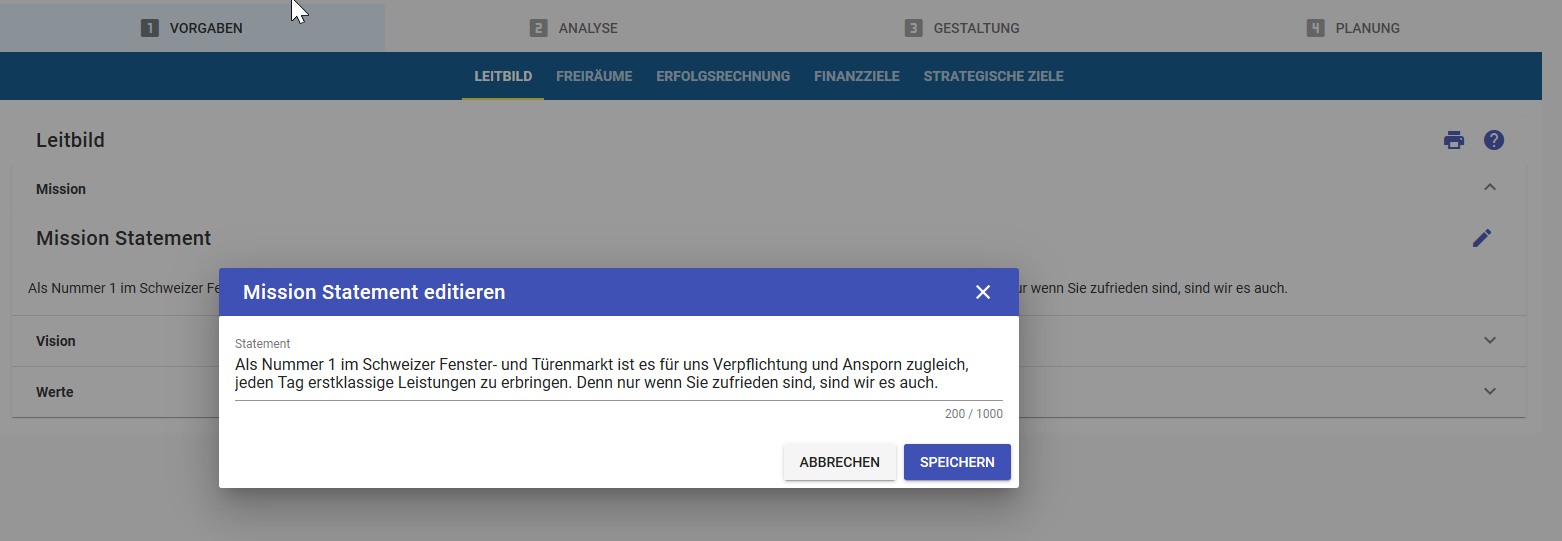
A definition of mission statement, mission, vision and values is given in the guide, which you can download on the download icon at the top right of the page.
Guidelines
The open spaces are guardrails. They are dictated by the management and describe everything we do not want to do. These are strategic decisions that have to be considered in the strategy development.

These free spaces can be edited for each given parameter.
Profit and Loss
If the income statement can not be split between the business units, the numbers are entered here. That also means that the profit and loss statements of the business units remain empty.
You can also enter a part here and break down the rest to the business units. This is an advantage if you have split the first levels (sales, gross margin, CM II), but the other levels (up to EBIT) are only available as a total.
At the moment it is not checked whether entries are made on one level only - so be careful.
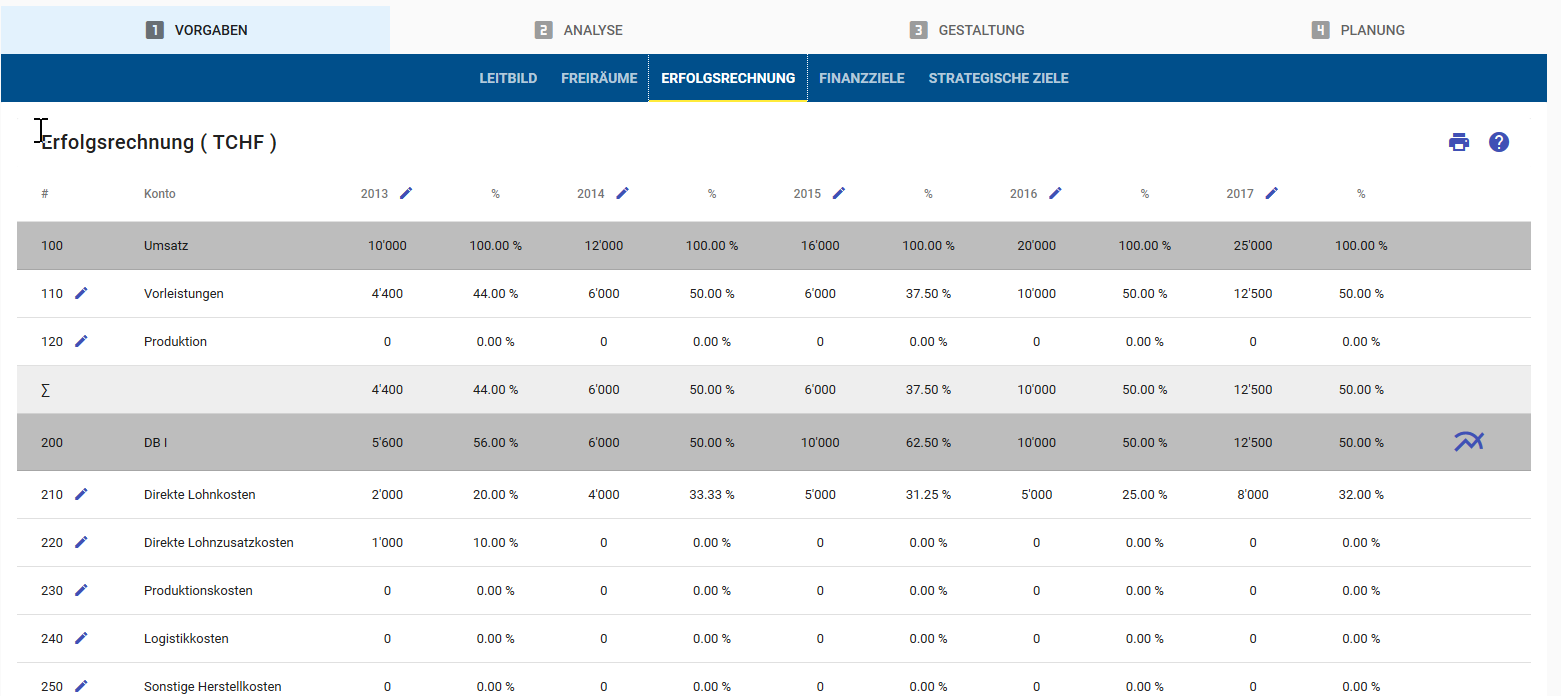
On the right on the lines of the contribution margins you find an icon for the chart. This takes each of the sales and the contribution margin as an absolute number, and also represents the selected CM as a percentage. This percentage refers to the right axis.
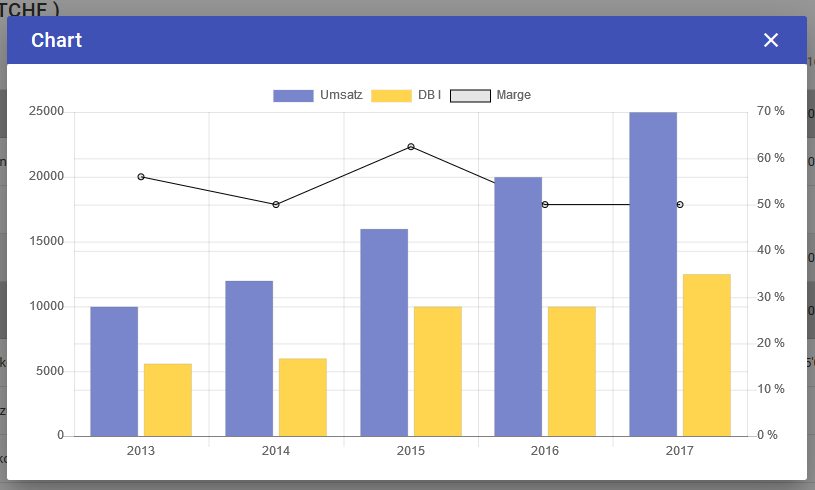
Financial Goals
The financial targets can be specified for each contribution margin defined in the chart of accounts. These goals can be entered separately for each following year. Alternatively, enter the goal for the last year and click on the icon on the right (left arrow); thus, the goal is linearly calculated back to the current year and distributed.
Below the first year, you specify which business area dimension is taken as the basis. This dimension can be selected during editing.

By clicking on a CM line, the goals for each CM level are displayed as a chart:

Strategic Goals
The strategic goals relate to the KPIs defined in the parameterization. By default, these are the dimensions:
- Customer focus
- Innovative ability
- Market position
- Cost item
- Knowledge position
with their respective characteristics:
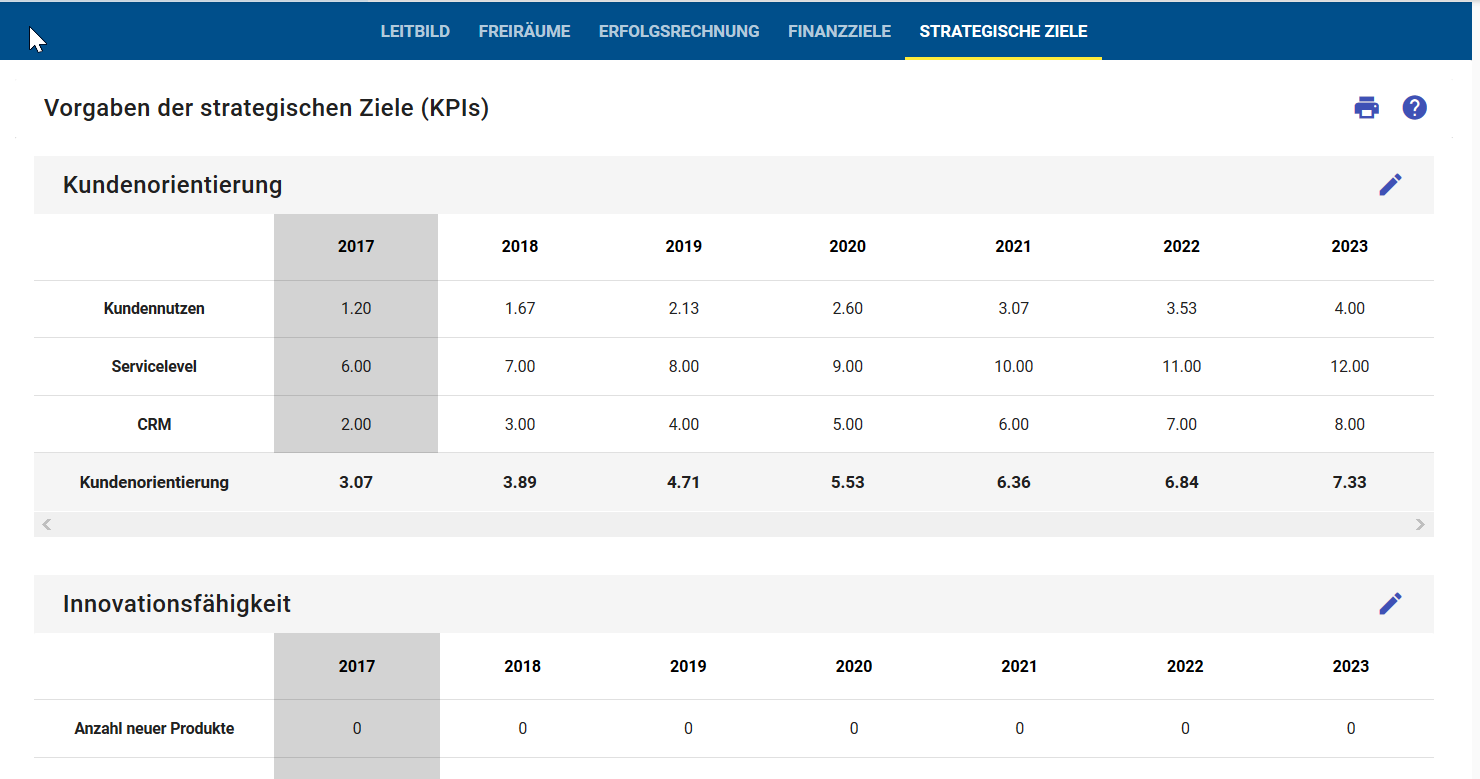
The goals entered here refer to the last year specified in the timeframe. That The numbers we enter are set to this year and are calculated back linearly to the current year.
For each dimension, a dialog window can be opened for editing:
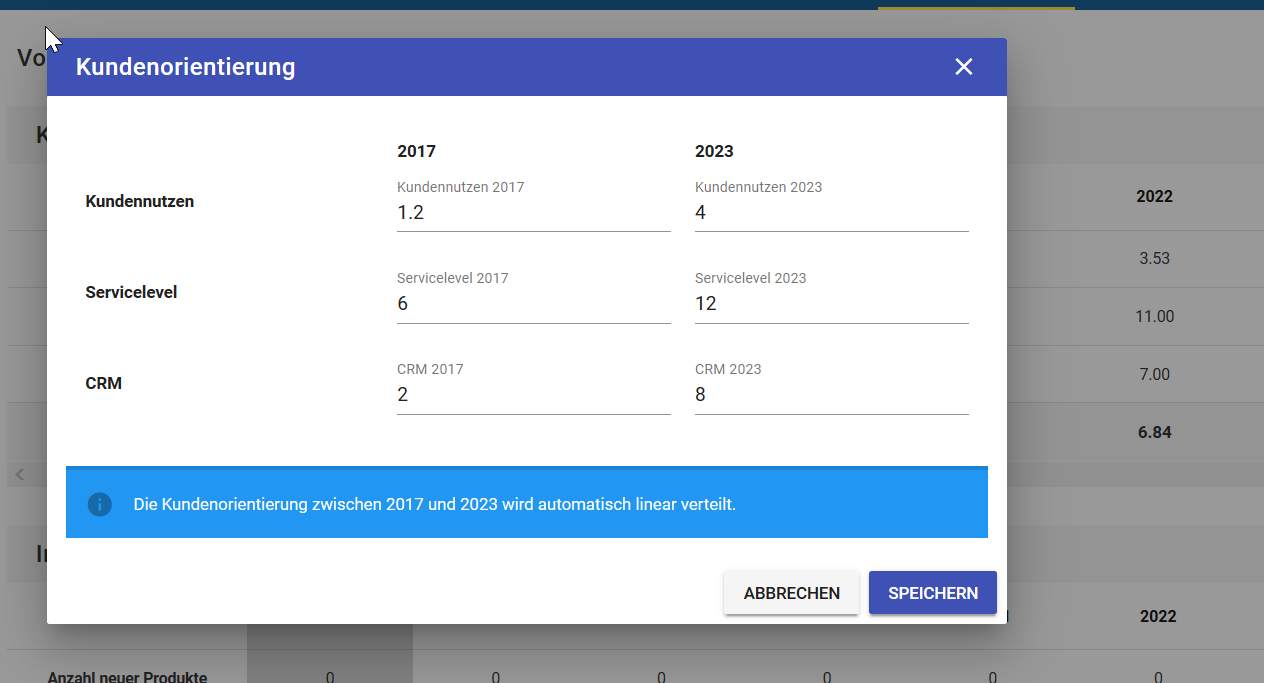
Analysis Phase
The Analysis section lists all instruments that are used by default and those that you have selected. For each analysis instrument, the SWOT elements are derived, which then are passed to the SWOT where they are displayed as analysis results.

Profit and Loss
At the company level, the income statements of all business units of a dimension are consolidated. The numbers of these income statements can not be edited here.
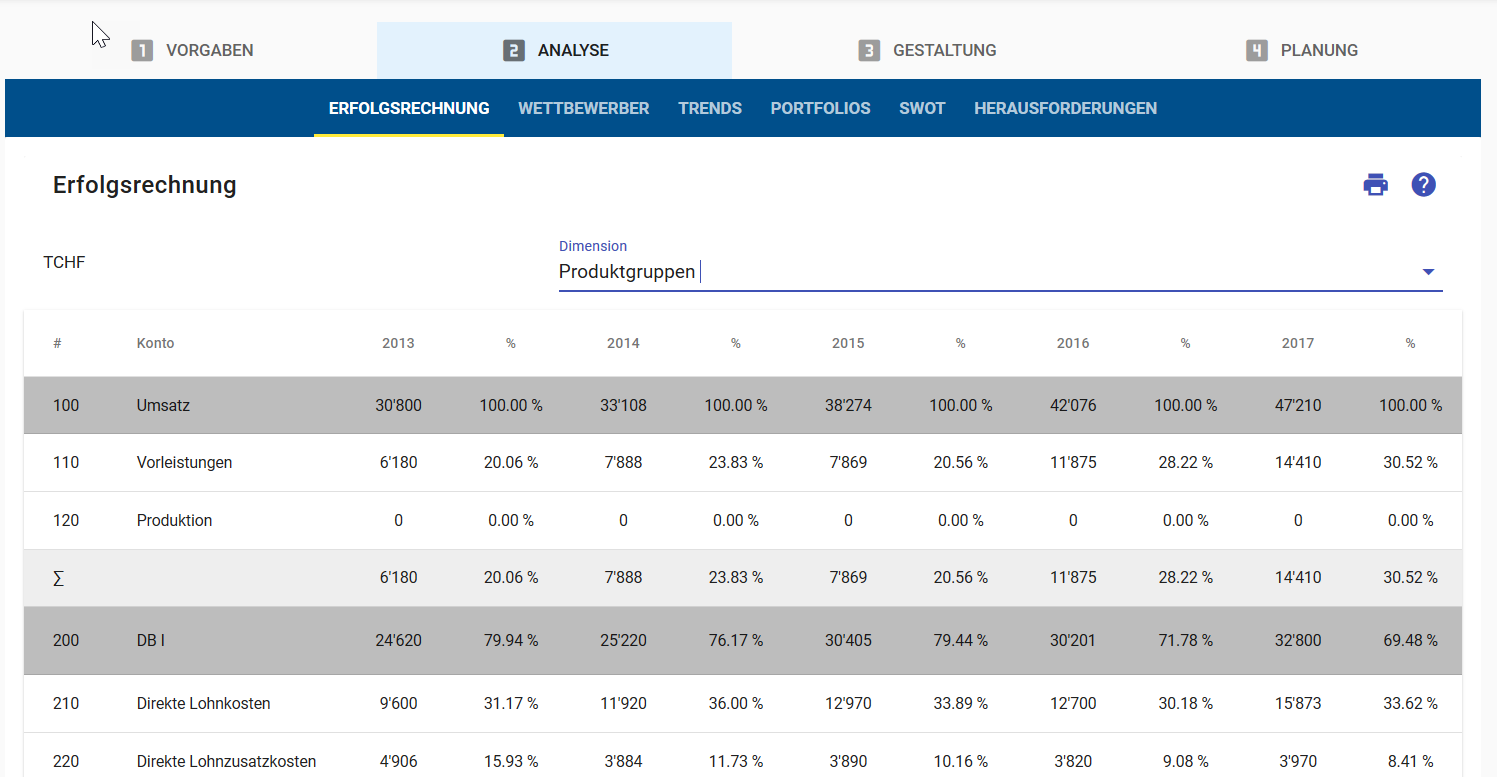
The dimensions can be selected top right in the drop-down.
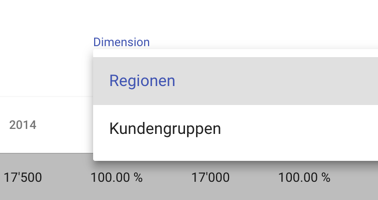
On the right on the lines of the contribution margins you find an icon for the chart. This takes each of the sales and the contribution margin as an absolute number, and also represents the selected CM as a percentage. This percentage refers to the right axis.
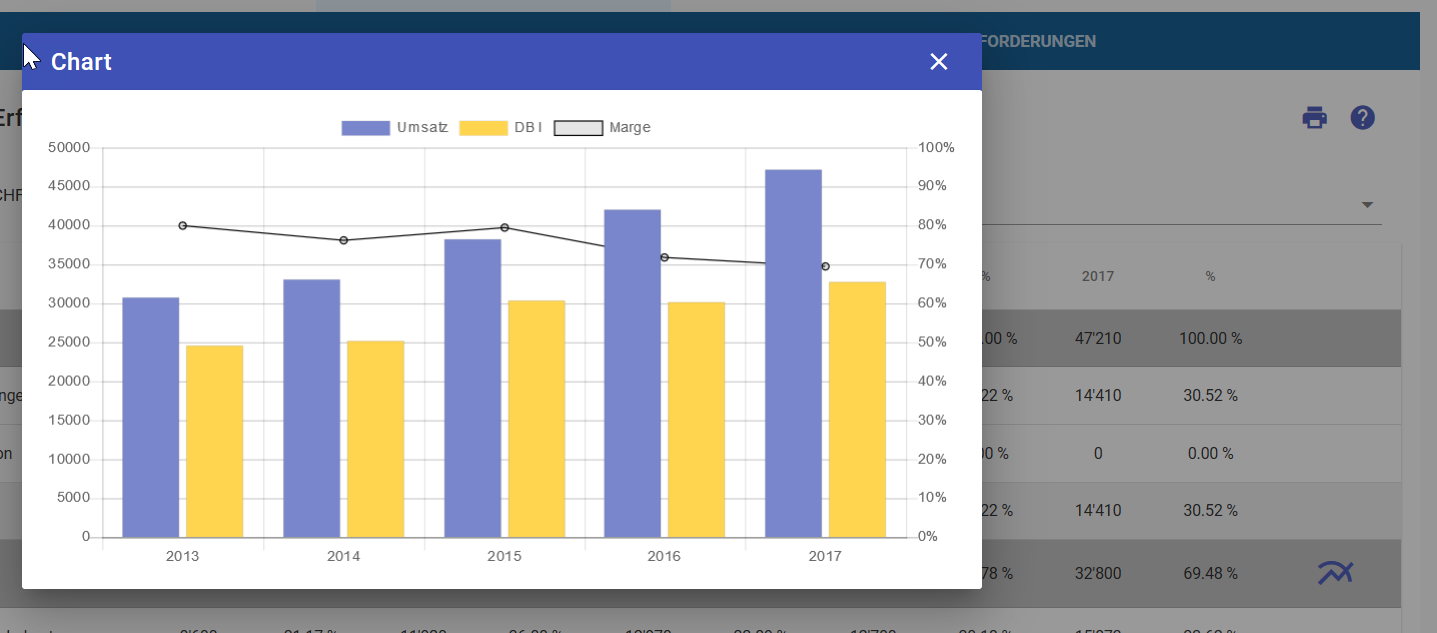
For each analysis instrument, the SWOT elements are now derived. To do this, click on the plus icon below and a dialog box will open:
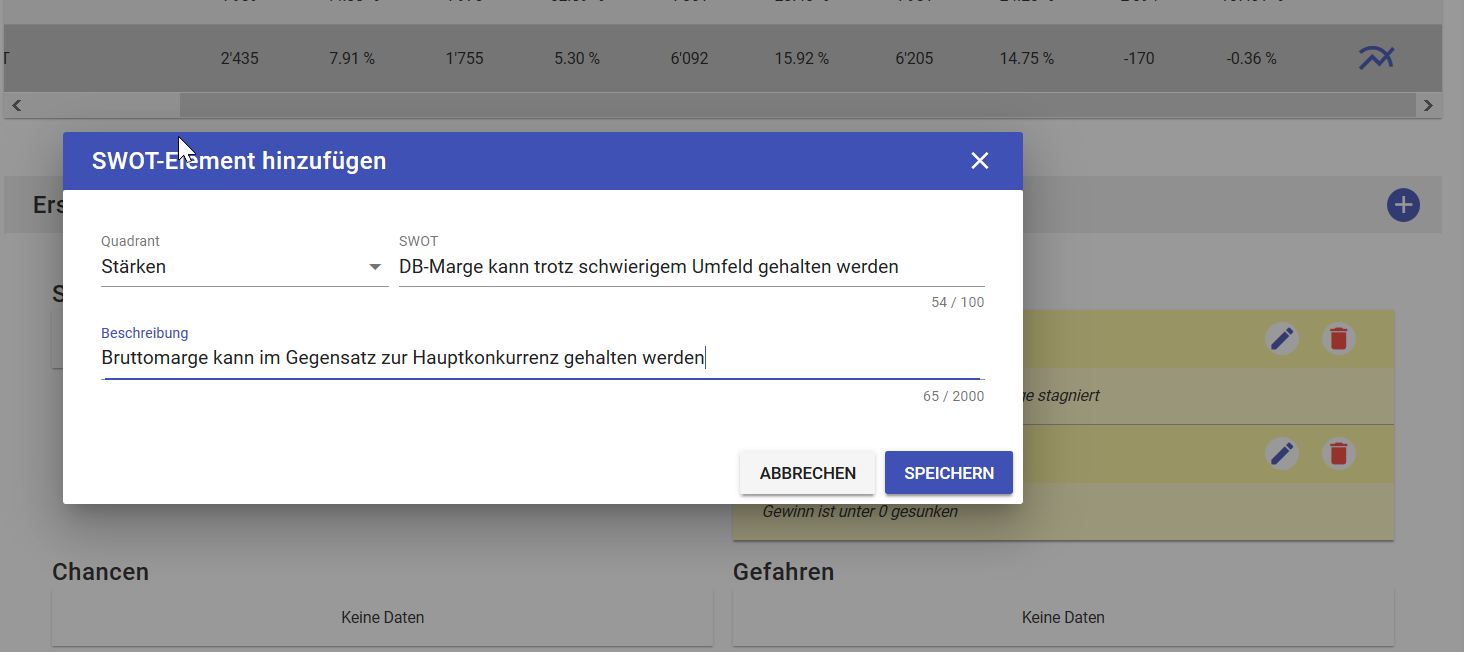
These are derived directly from the results of the table and subsequently appear in the SWOT, stating the origin of the SWOT element.
Competitors
All competitors we've covered are listed at the company level. The description fields are taken from the configuration.
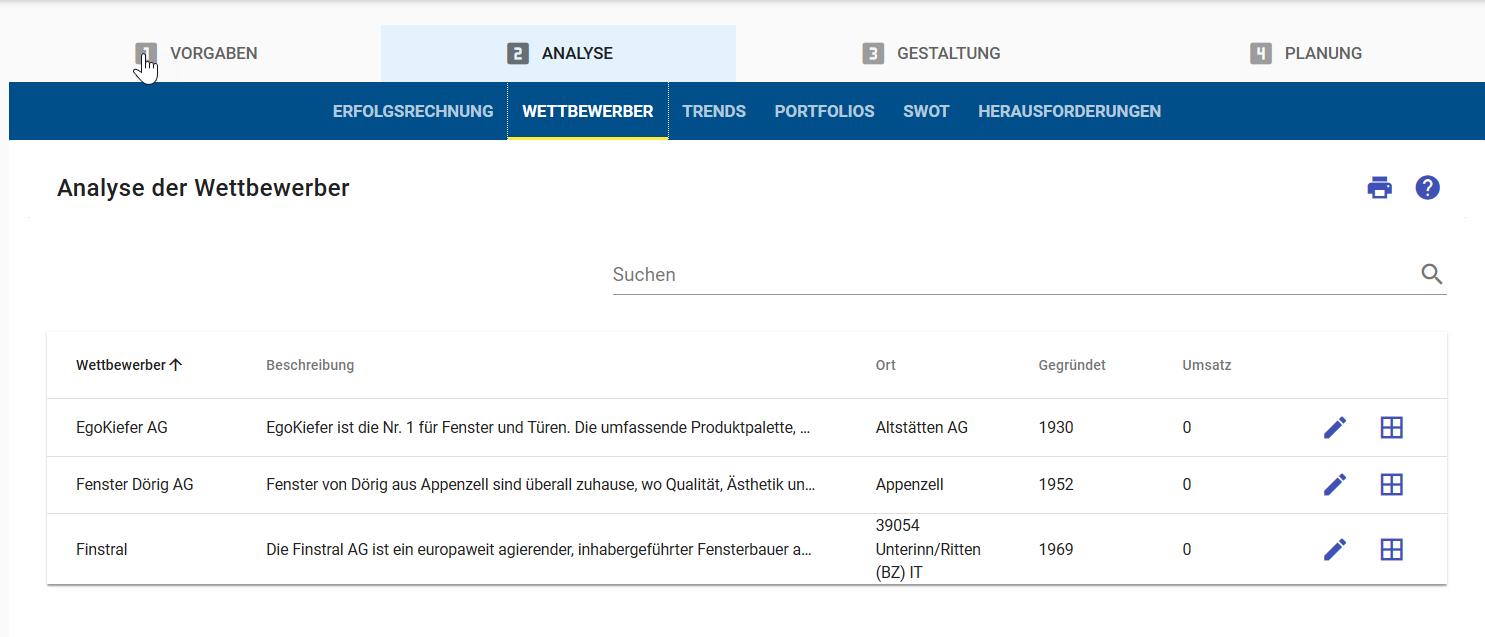
There are two dialog windows available:
- Edit: input and adjustment of competitor data and descriptions
- SWOT: Enter each of the competitor's three strengths and weaknesses and the corresponding weaknesses and strengths of your company.
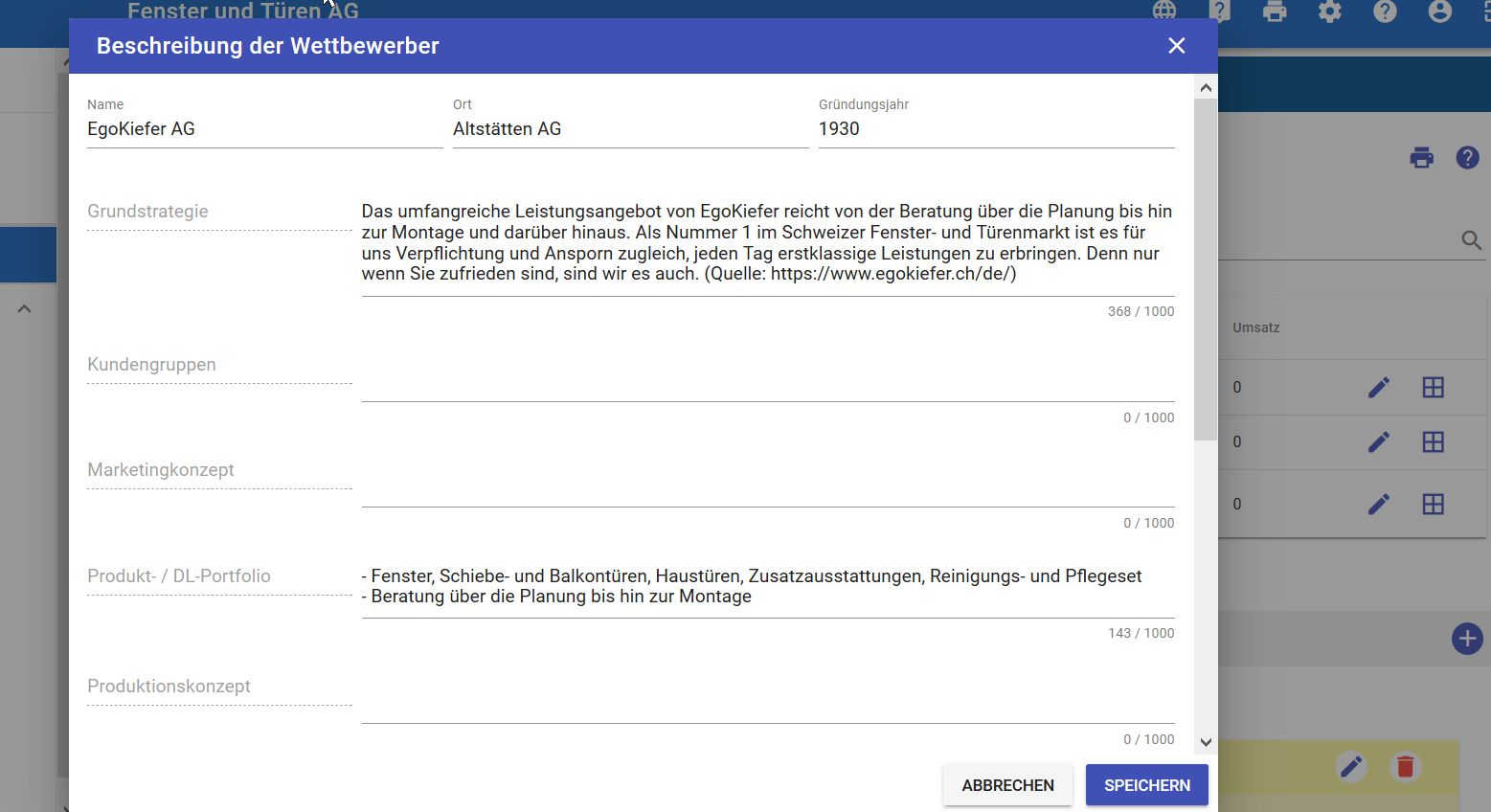
For each competitor, the 3 strengths are compared to our weaknesses and the 3 weaknesses to our strengths
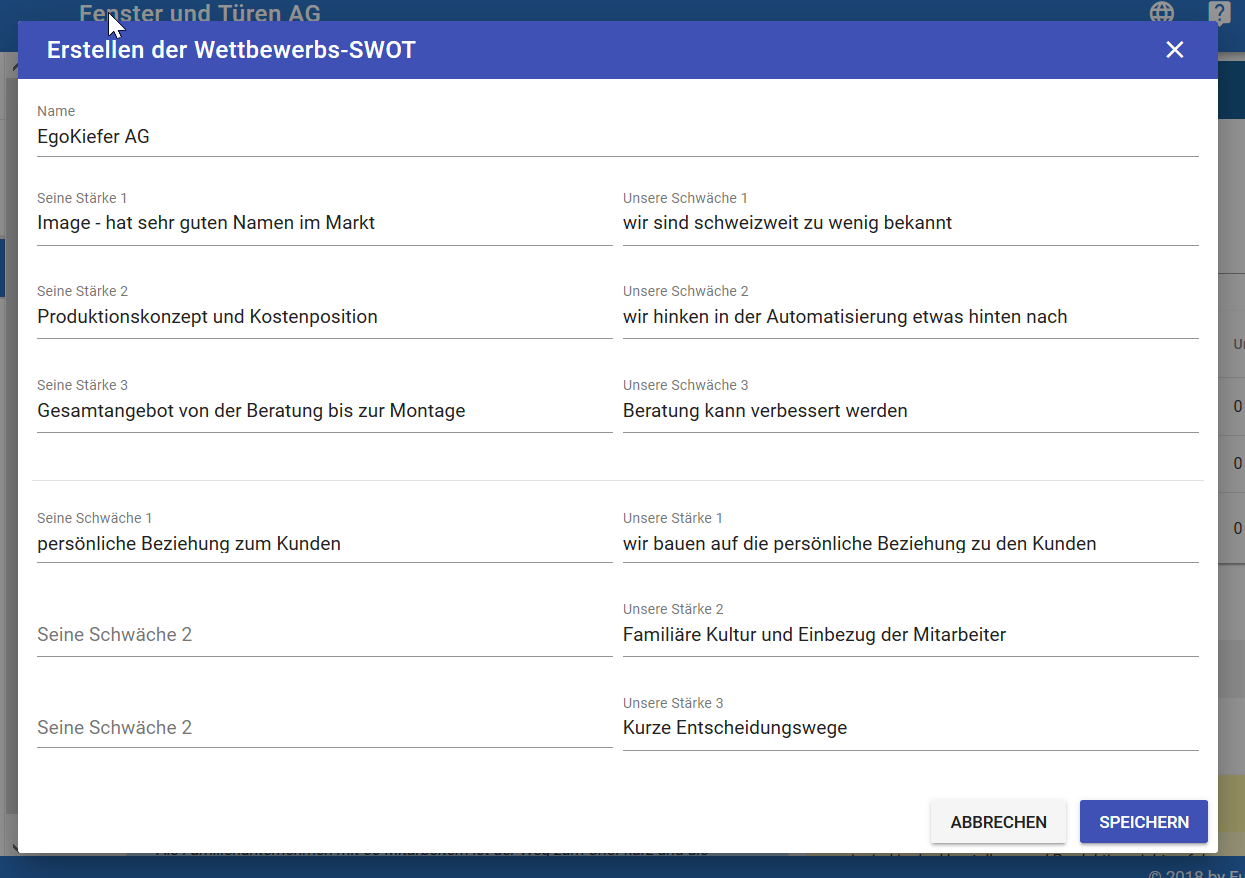
Here, too, the corresponding elements (strengths, weaknesses, opportunities, threats) can be derived for the SWOT.
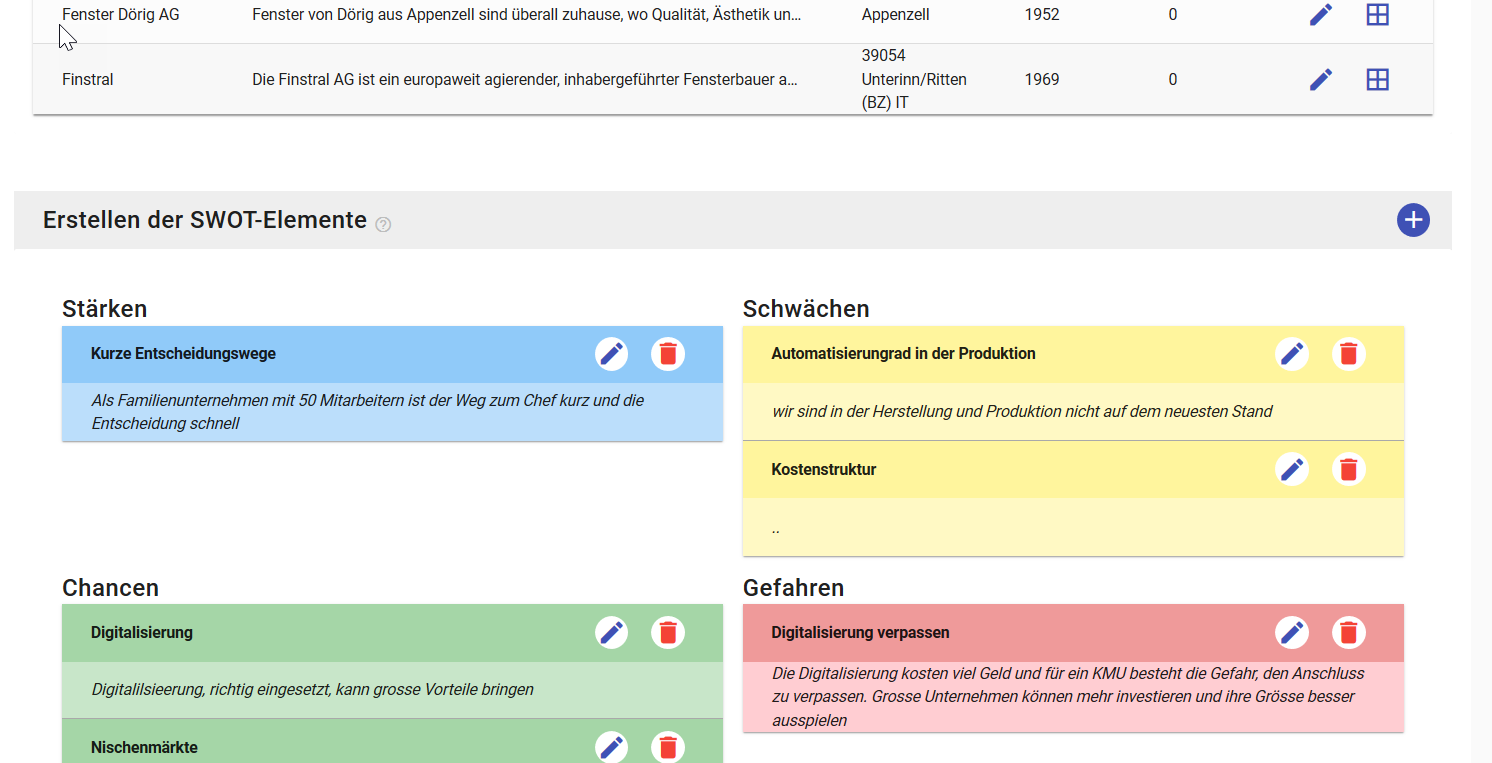
Trends
The trend analysis is the basic instrument for strategy development. We divide the trends into three groups:
- External trends
- Internal trends
- Competitive trends
These three groups appear as a list and can be expanded.

Click on a line to enter and edit the individual trends:
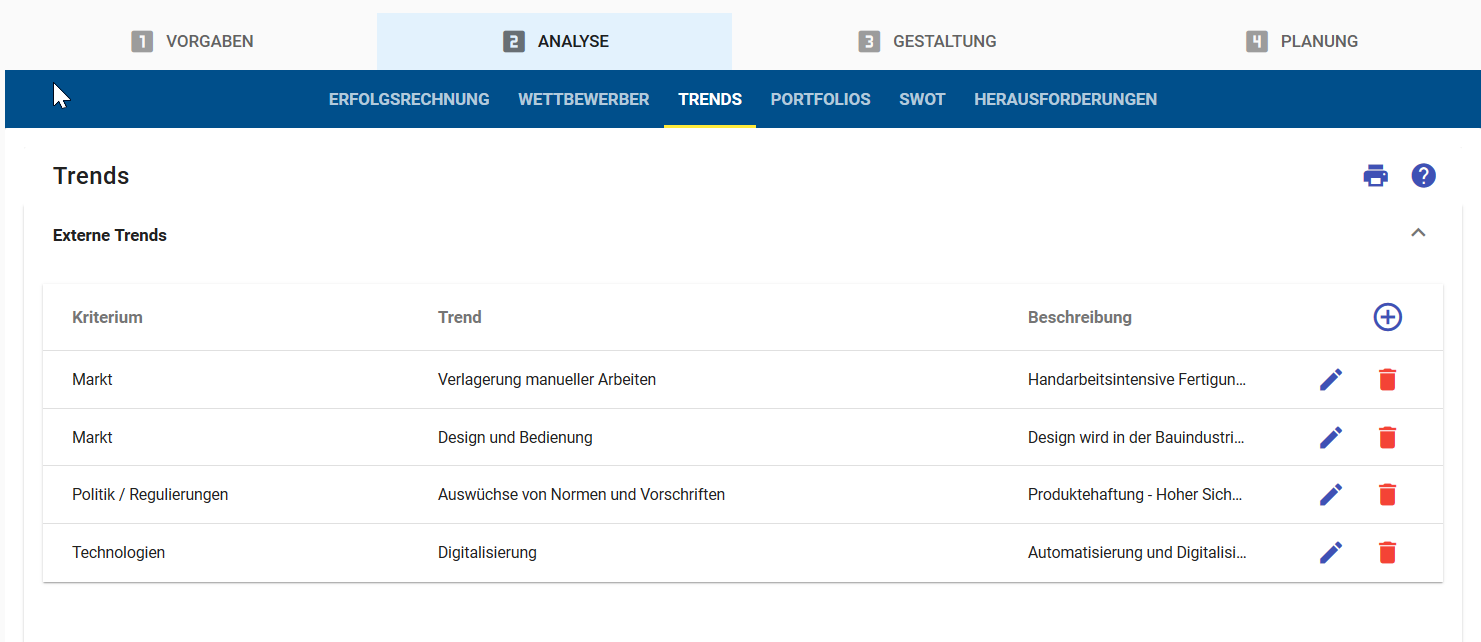
From each group, the SWOT elements can be derived, which then flow into the corporate SWOT.
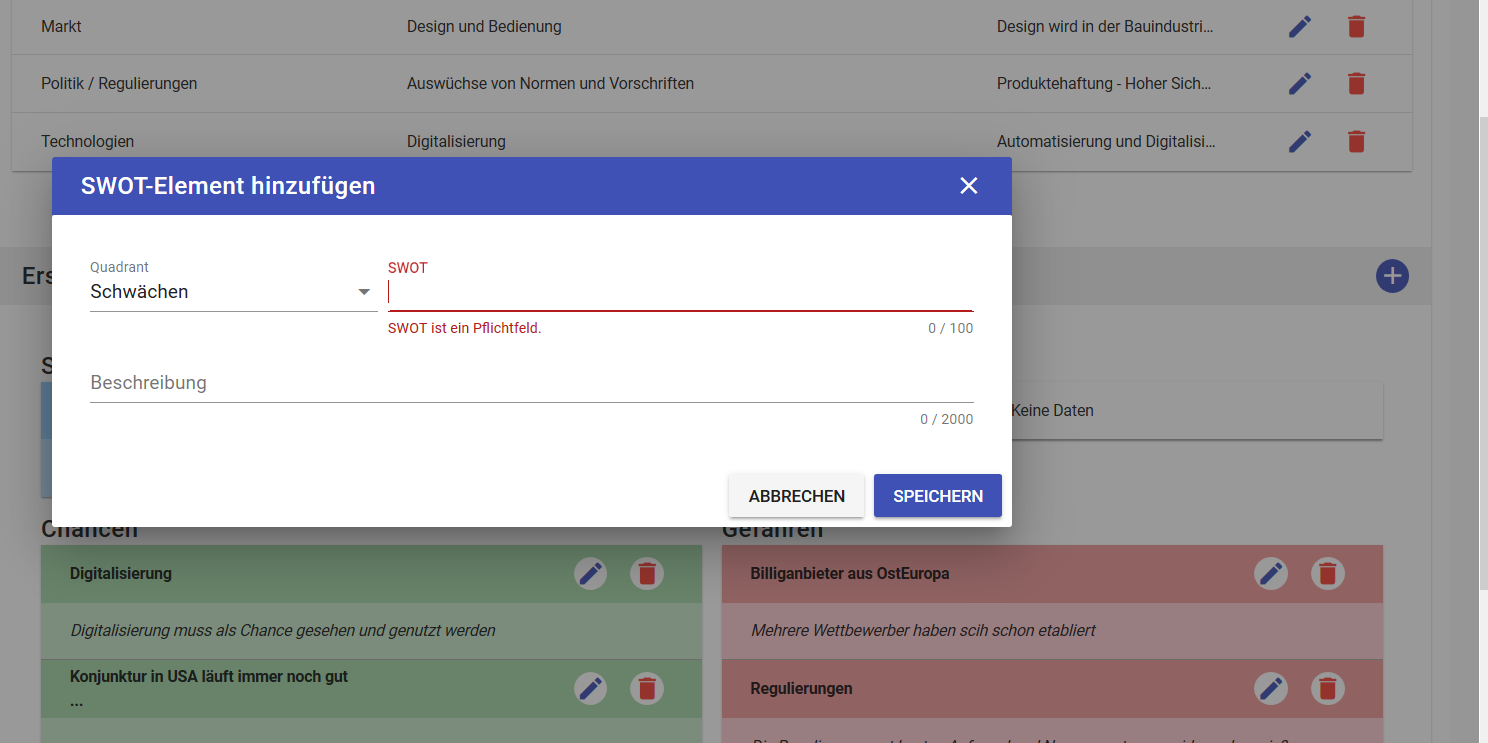
Portfolios
For each dimension specified in the structure in the configuration section, a business portfolio appears.
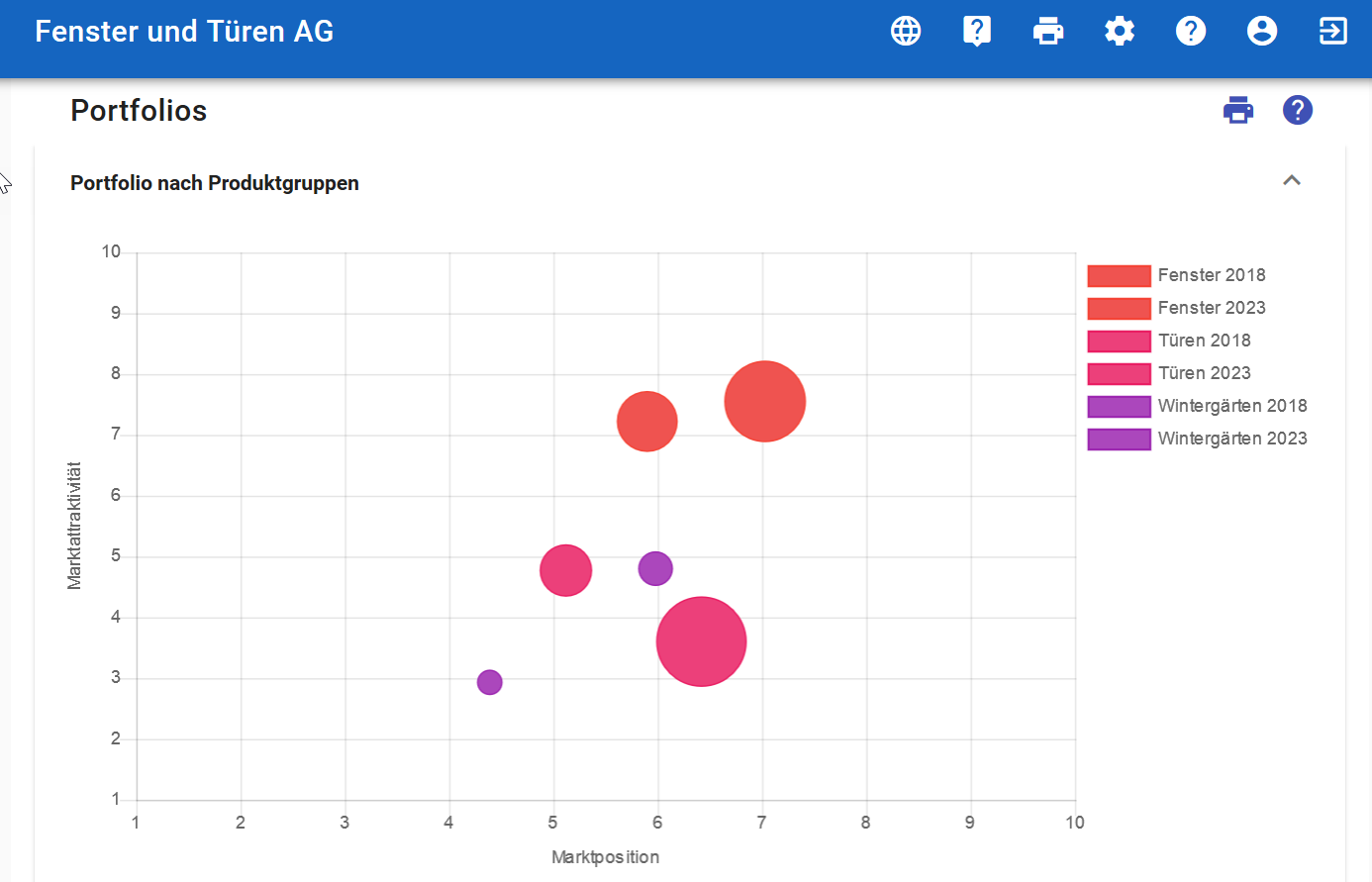
The data comes from the information provided by the business area strategies.
And then enter the SWOT elements again, which are then displayed in the SWOT.

SWOT
The SWOT is the result of the analysis. All SWOT elements from the analysis tools appear here in a long list, which is listed on the left. Partially overlapping there might be double entries and the elements may not all be equally relevant.
The elements can be further edited here and it is also possible to add more, e.g. as a summary of existing ones.
To obtain an aggregated summary of the assessment of the initial situation, select the three to a maximum of seven relevant elements from the list on the left per quadrant and drag them to the right by clicking on the arrow.
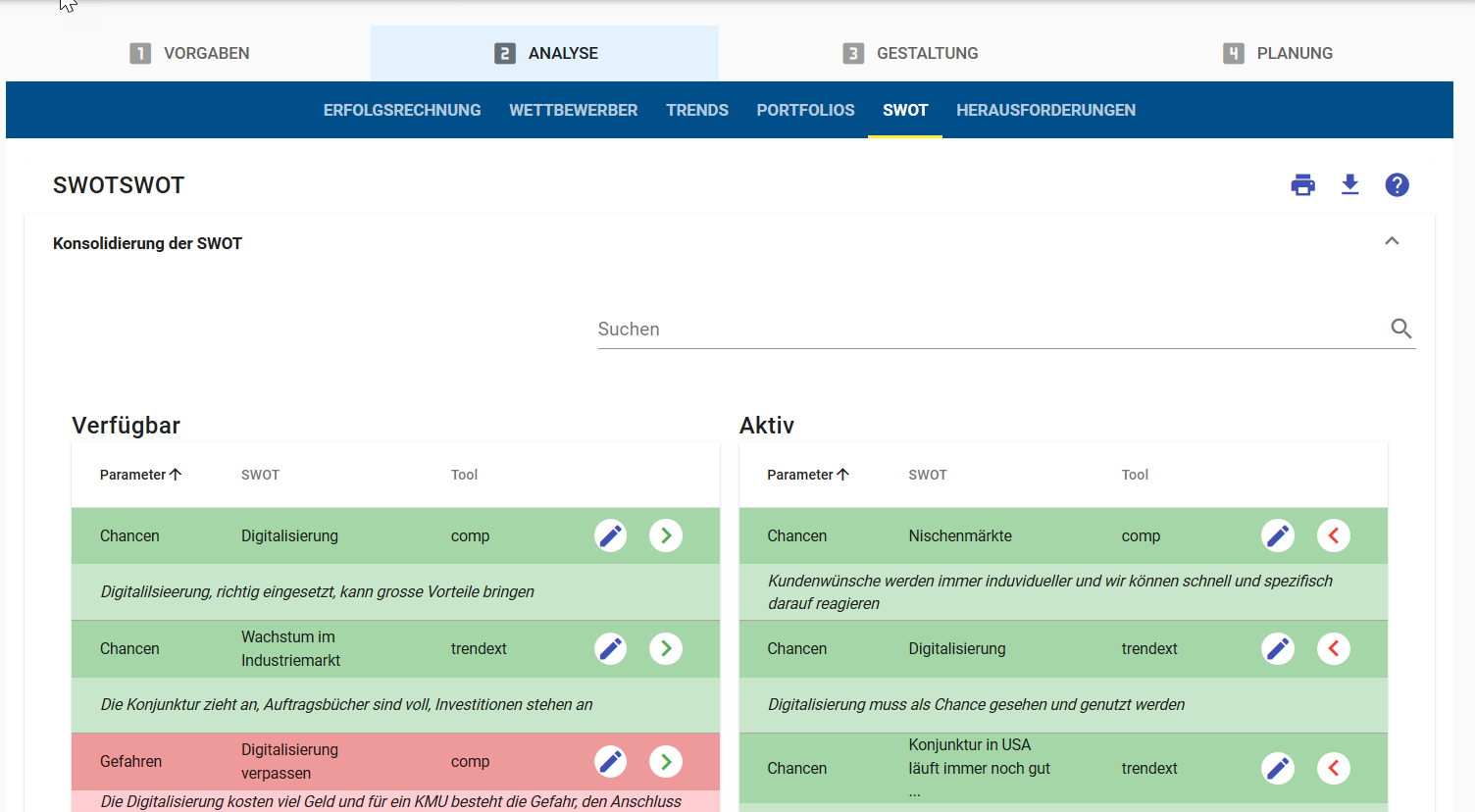
This gives us a consolidated SWOT, from which we derive the main challenges in the next step:
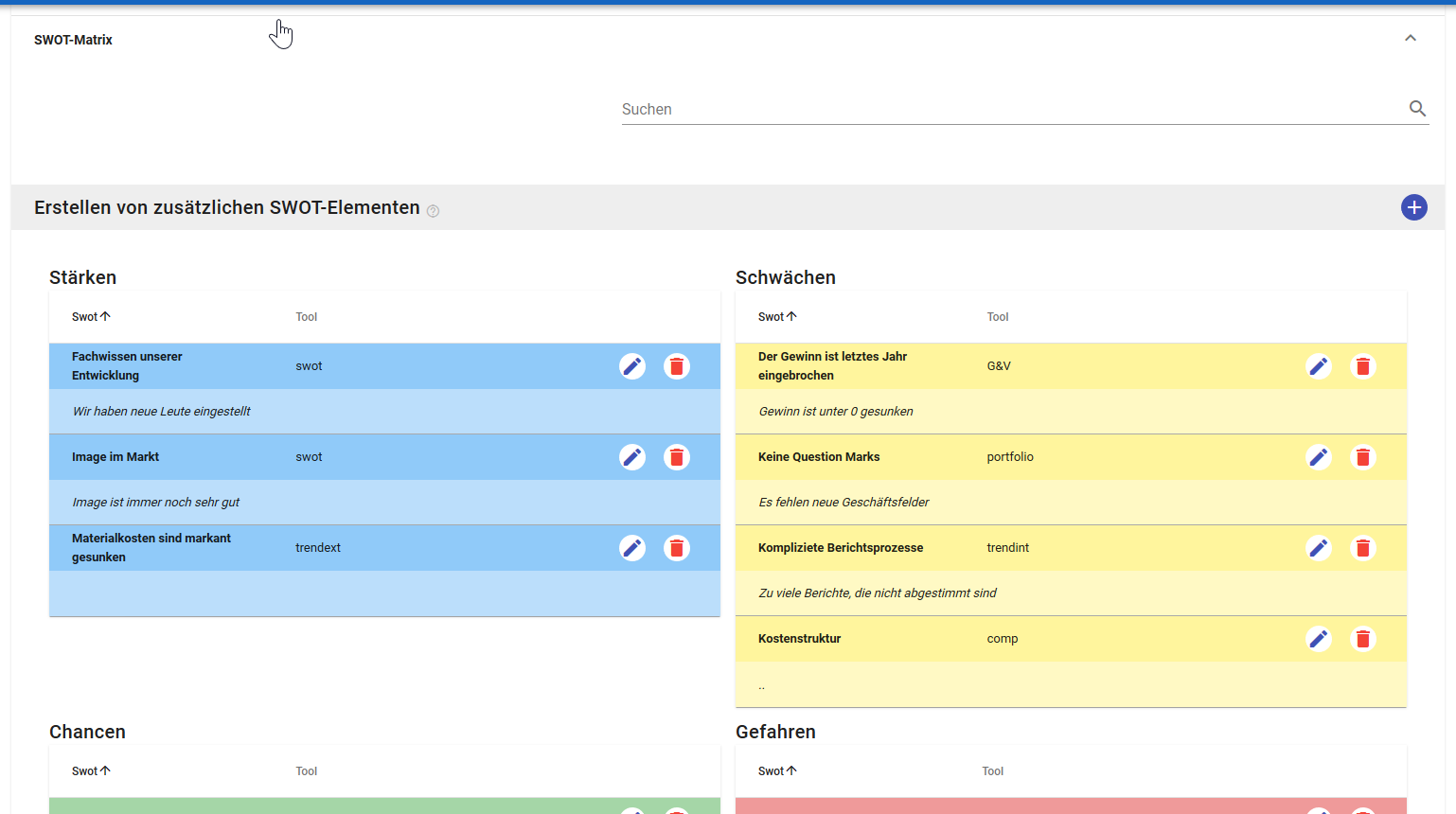
The SWOT elements can be edited here and also deleted and it is possible to add further elements. Each element indicates where it was created, and thus we have an analytical derivation of the SWOT.
Note: It is also possible to omit the analysis and to start with the SWOT by entering it here directly - and the effort for the strategy can be significantly reduced.
Challenges
The main challenges are derived from the SWOT. This is done in an "analogue workshop" - with maps and a lot of space. The instructions can be found under the download icon on the top right. The result is a list of approximately 10 - 15 major challenges, each associated with a quadrant. The main challenges thus worked out are now entered as a list with title and description as well as indication of the quadrant.
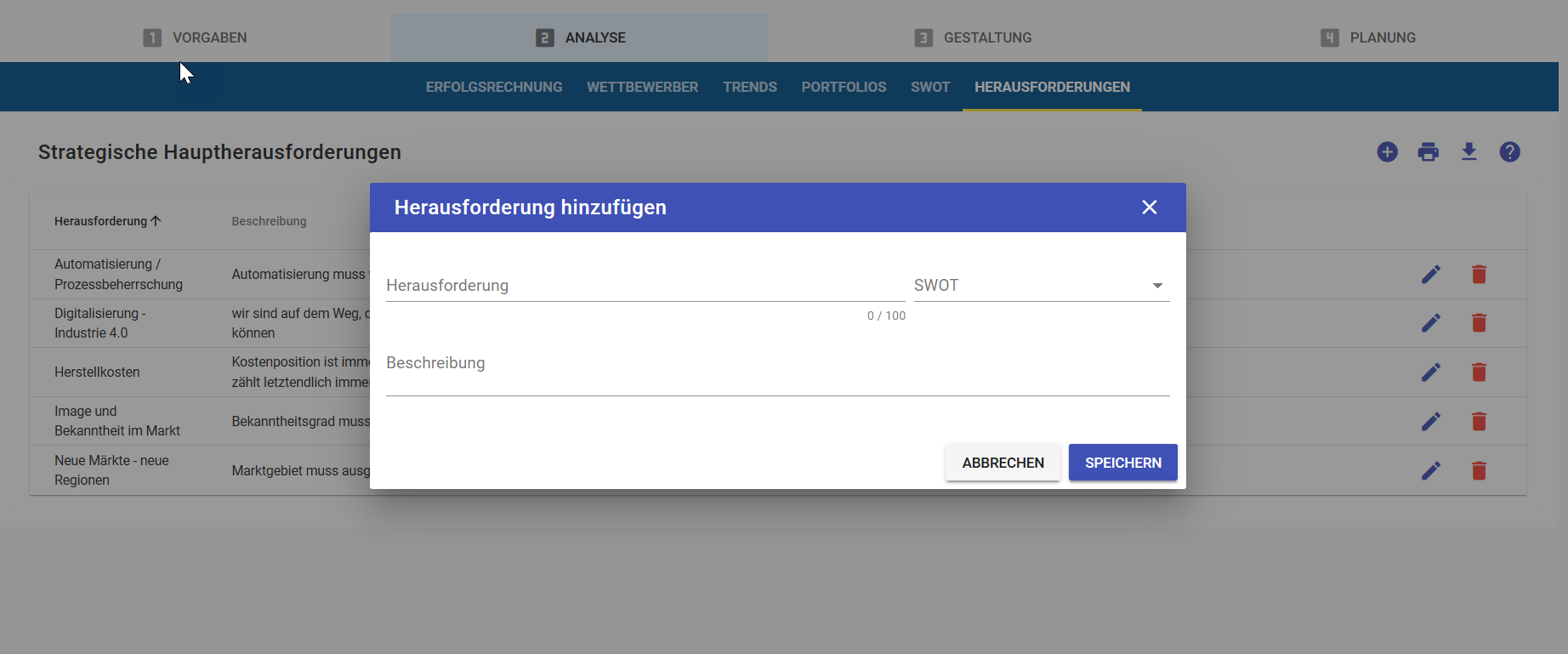
These key challenges will be compared with the strategic options in the next phase. This can be used to check whether the strategic orientation is consistent or whether there are strategic gaps.
Design Phase
Die Gestaltung der Strategie findet auf der Ebene der strategischen Geschäftsfelder statt (daher auch der Name). Auf Unternehmensebene erhalten wir eine kongregierte Darstellung mit verschiedenen Auswertungen.
Jedoch können wir auch aus der SWOT des Unternehmens Optionen ableiten und diese den Geschäftsfeldern zuordnen. Zusätzlich werden die internen Optionen auf Unternehmensebene erfasst.
Die Gestaltungsphase auf der Unternehmensebene wird unterteilt in die Schritte:
- Optionen
- Adjacencies
- SWOT-GAP-Analyse
- Stossrichtungen

Options
The options can be entered at the BU level as well as at the company level. At the BU level, it is only possible to create the options for the BU concerned. At the company level, options can be created for all business units. Likewise, all internal options are created here. So these are strategic options that affect the company as a whole or a functional area, e.g. the marketing as a whole.
The input is based on the SWOT and in each case from one of the quadrants, which we have defined in the parameters:
- Strengths / Opportunities -> ST / OP
- Opportunities / Weaknesses -> OP / WE
- Weaknesses / Threats -> WE / TH
- Threats / Strengths -> TH / ST
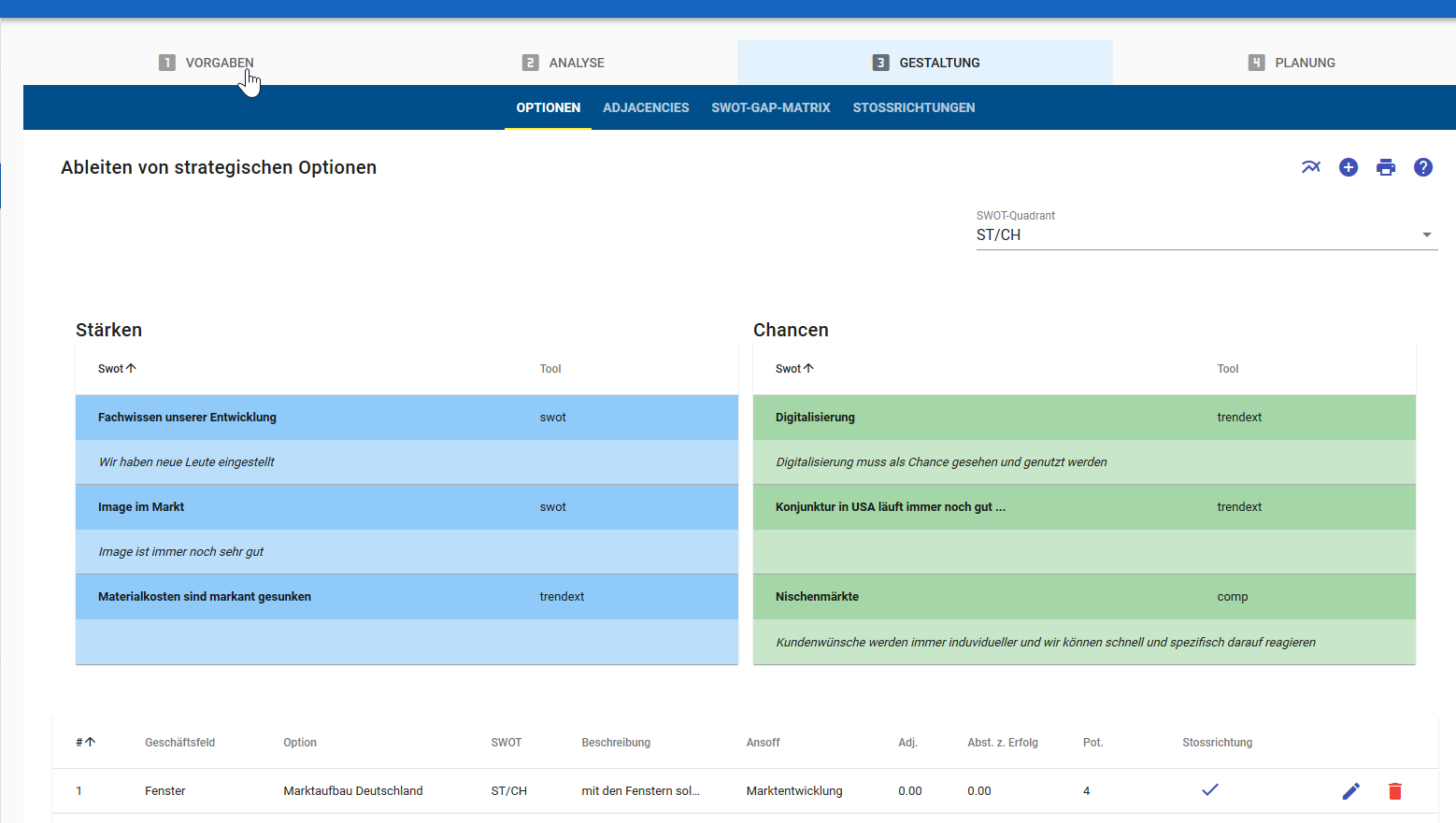
If SWOT has been created for the entire company, and not individually for each BU, options can be derived from the corporate SWOT and assigned to the GF or marked as an internal option, which refers to the entire company.

The options are described in the dialog box and then the values for the adjacencies are listed as defined in the parameters:
- Adjacencies: customers, customer issues, products, regions, technologies,
- Distance to success: Investments, time to first sales, there is already a market today, building up know-how

We give each of the parameters a value between 1 and 5 with the following meaning:
Evaluation of adjacencies (y-axis)
| Value | the option |
|---|---|
| 1 | ... is part of the core business |
| 2 | ... is close to the core business |
| 3 | ... is further away |
| 4 | ... has little to do with the core business |
| 5 | ... moves in completely new realms |
Evaluation for the distance to success (x-axis)
| Value | the distance |
|---|---|
| 1 | ... is low - business can be realized immediately |
| 2 | ... is low |
| 3 | ... is in not to big |
| 4 | ... is high |
| 5 | ... is very high - it has to be invested a lot and takes its time |
In addition to the values for the Adajcencies, we give an initial estimate of the potential, on a scale of 1 to 10. 1 means: the potential is very low, 10 means the potential is very high. Which values you use for this scale depends on the nature of your business and can be determined by you. As a rule of thumb: For a potential of the order of 10% of the turnover (of the company) we suggest 10 points.
Here, two options were created from the quadrant strengths / opportunities and assigned to the business field "window", an option was marked as an internal option:

From these options, click on the plus icon in the options line to create the strategic directions. Strategic directions are concretized options, i.e. the ideas are formulated here and provided with potential, so that the results can be compared later with the requirements.
Adjacencies
The Adacency chart evaluates the options based on the two criteria:
- Distance to core business (Adjacency)
- Distance to success

On the left you can see how many options have been created per business unit; these can be selected and displayed in the diagram.
SWOT-Gap-Matrix
With the SWOT gap analysis we do a first consistency test. For every major challenge we have derived from the SWOT, we should have at least one option that gives an answer. We do this test with a simple crosstab - with the options in the vertical and the main challenges as columns.
- If a line remains empty on the horizontal axis, there are options that pass the main challenges.
- If a column remains empty on the vertical axis, there is no strategic answer to a main challenge.
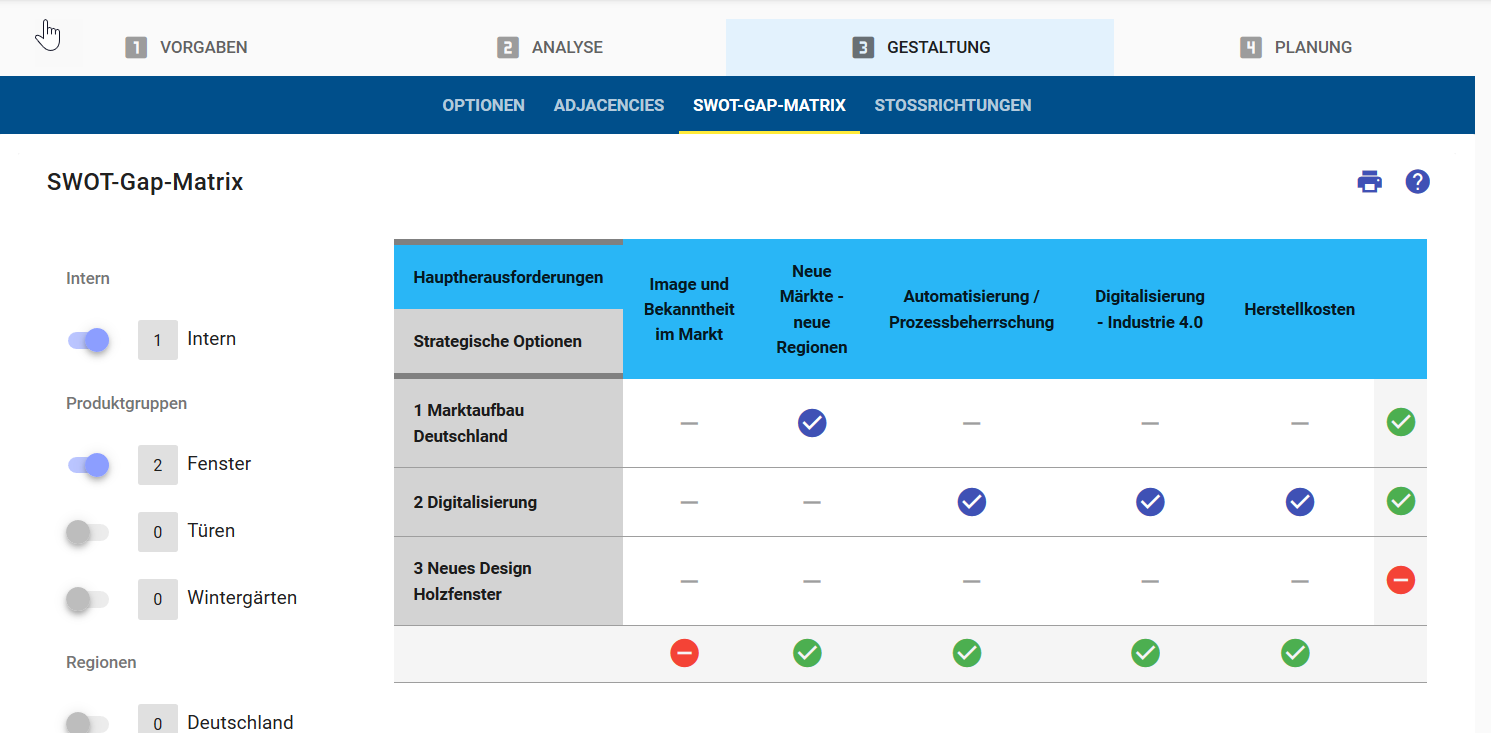
In both cases it is worthwhile to go over the books again.
Strategic Directions
Strategic direacitons are elaborated options. They are created from the options and concretely described on the basis of the given description fields. In addition, they are quantified, i.e. with potentials in the form of sales and CMs.
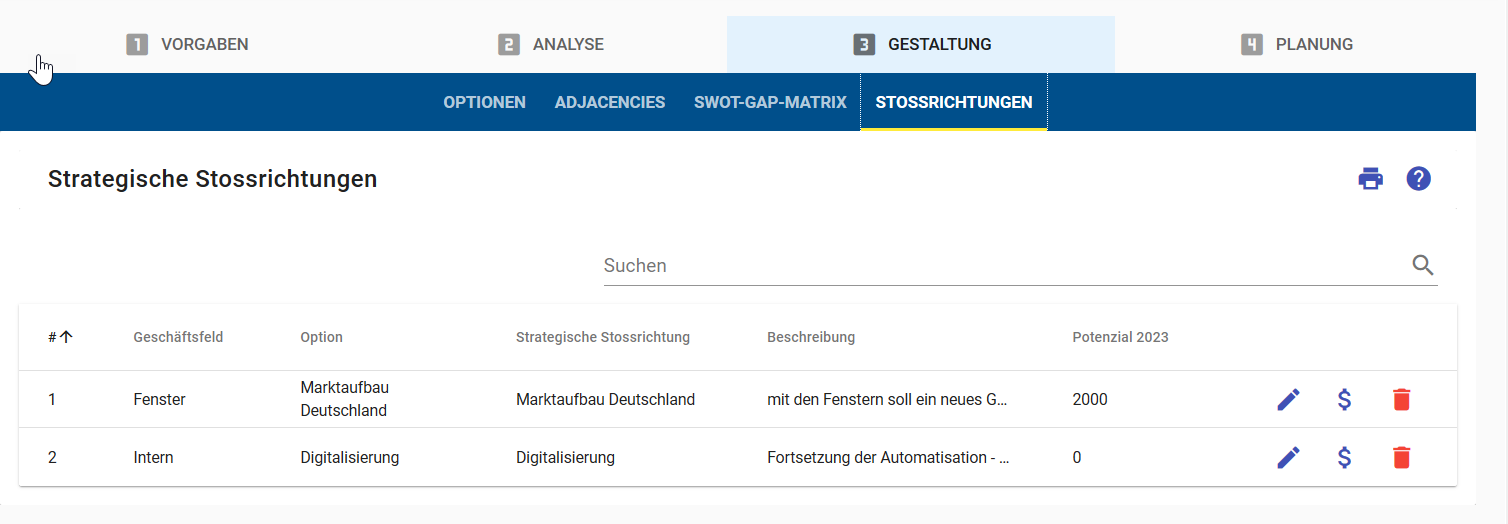
The description of the strategic directions follows the specifications entered during the parameterization of the instruments.
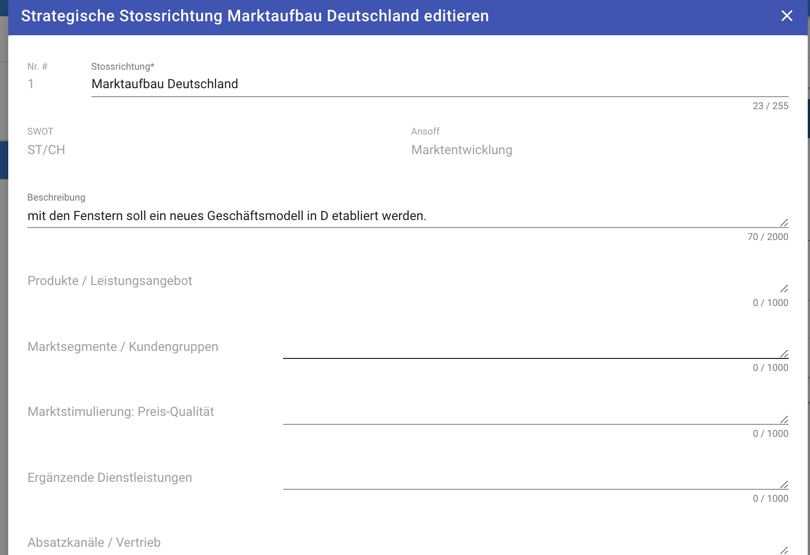
The potentials are entered in the following years. These relate to sales, margins and contribution margins, as specified in the chart of accounts. In addition, there are the two key figures investments and additional employees:

Planning Phase
The planning is divided into three steps
- Roadmap
- Financial Plan
- Measures

Roadmap
This presentation shows the company-wide evaluation of all directions: Which strategies can be used to achieve the goals? Here we can switch strategic directions on and off and see how we can achieve the given goals.
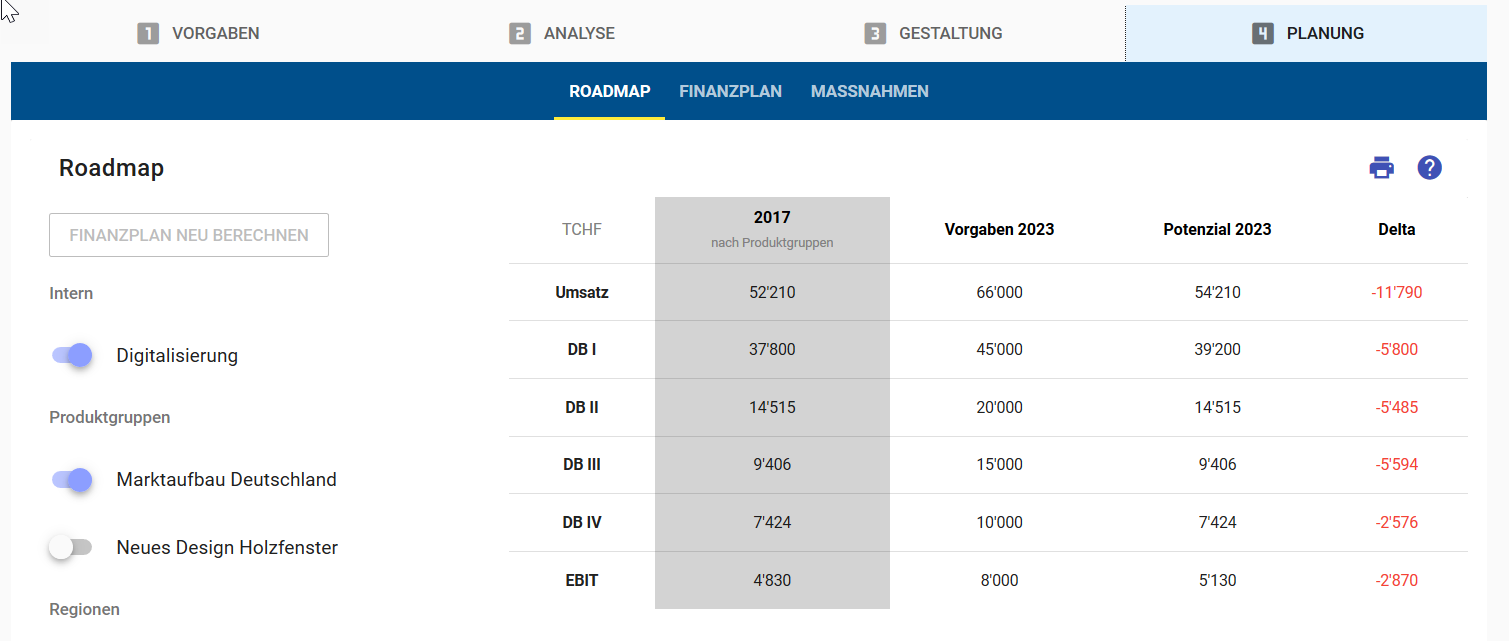
The results are shown directly in the chart:
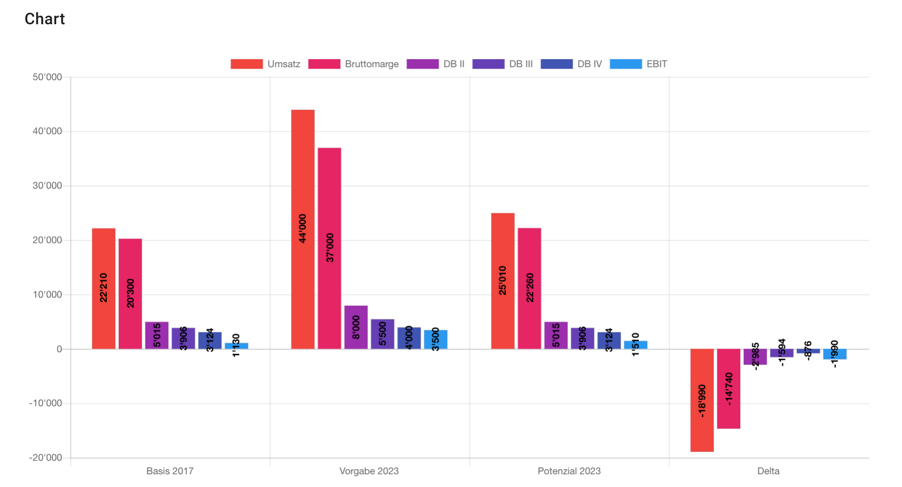
The selection of thrust directions is saved and then serves as a template for the financial plan. If something is changed, this template can be changed and the financial plan recalculated.
Recommendation: If the potential of all directions is about
twice as large as the projections, then we have
enough leeway.
- Set priorities by selecting the most promising directions.
- Make scenarios and try to present a worst /
real and best case scenario
Financial Plan
The financial plan is calculated from the roadmap and shows which goals are achieved. For each goal, the difference between potential and requirements is shown.
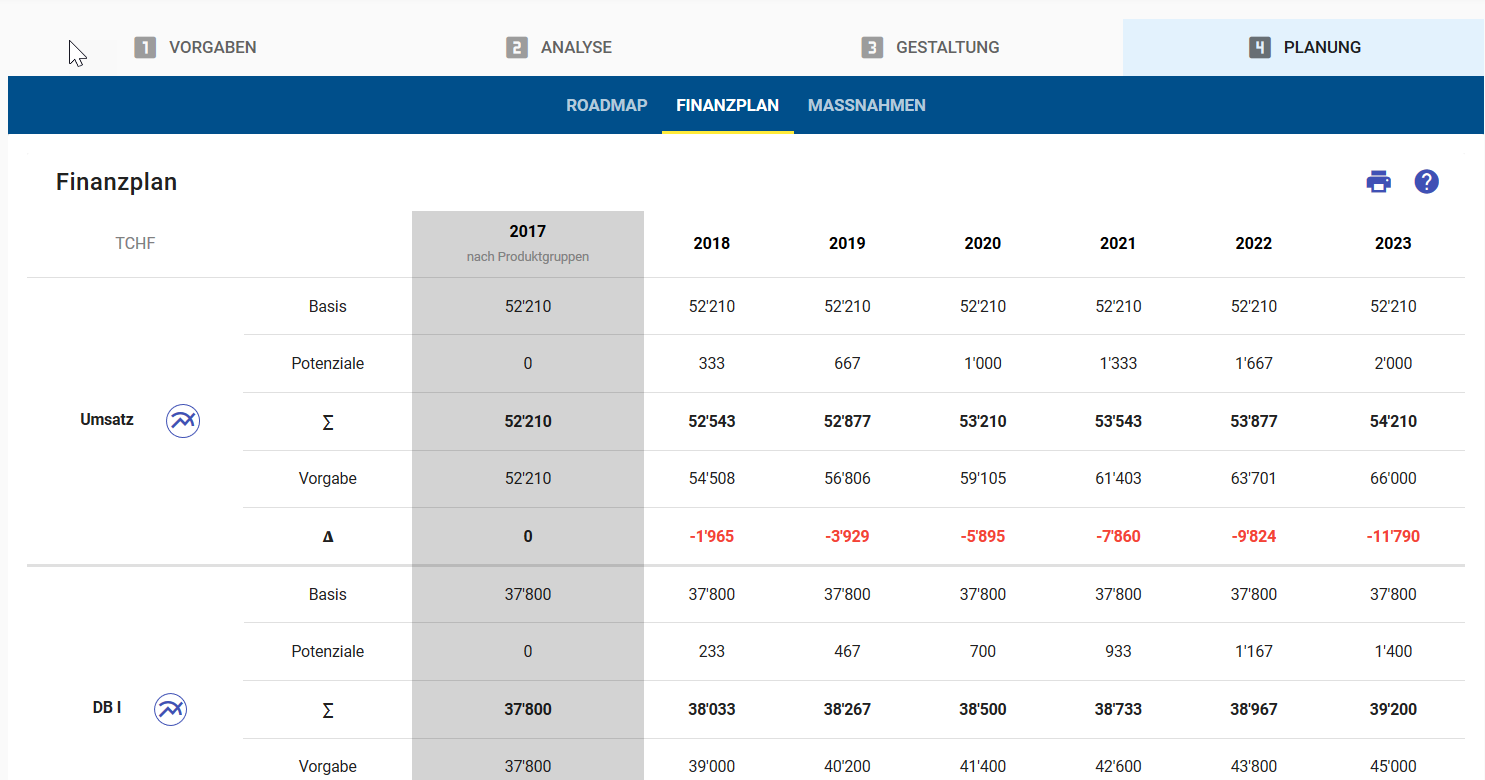
For each number, the following values are displayed:
- Base from the last completed year
- Potential as a buzzer of all directions
- Sum of possible results
- Specifications from the objectives
- Delta of requirements to results
For each key figure a chart can be created and printed out.
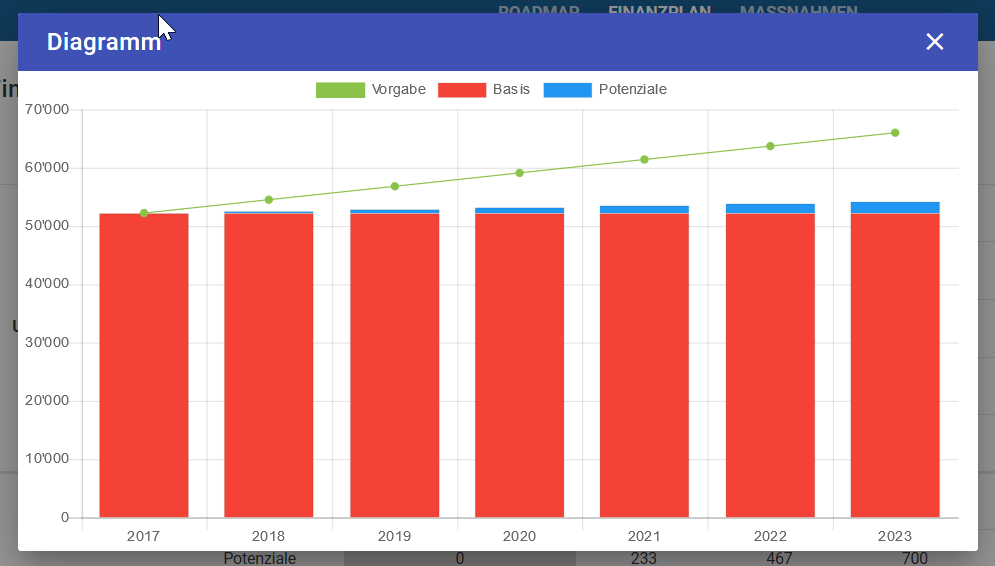
Measures
All the measures that were created in the course of the process are presented here in a consolidated list. The measures can be created on two bases:
- Strategic directions: For each direction marked in the roadmap and included in the financial plan, measures and activities can be created
- Main challenges: For every major challenge from the SWOT, measures and activities can also be defined. This is useful if you want to create measures directly from the SWOT without going through the options - strategic directions
- roadmap and budget.
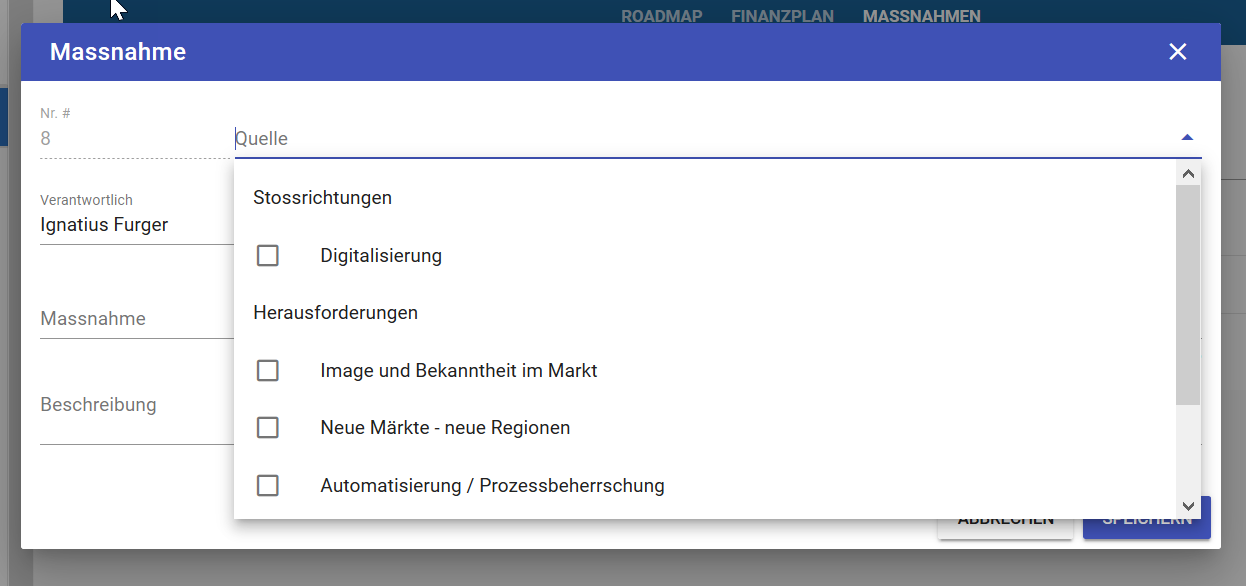
The measures are displayed as a list:
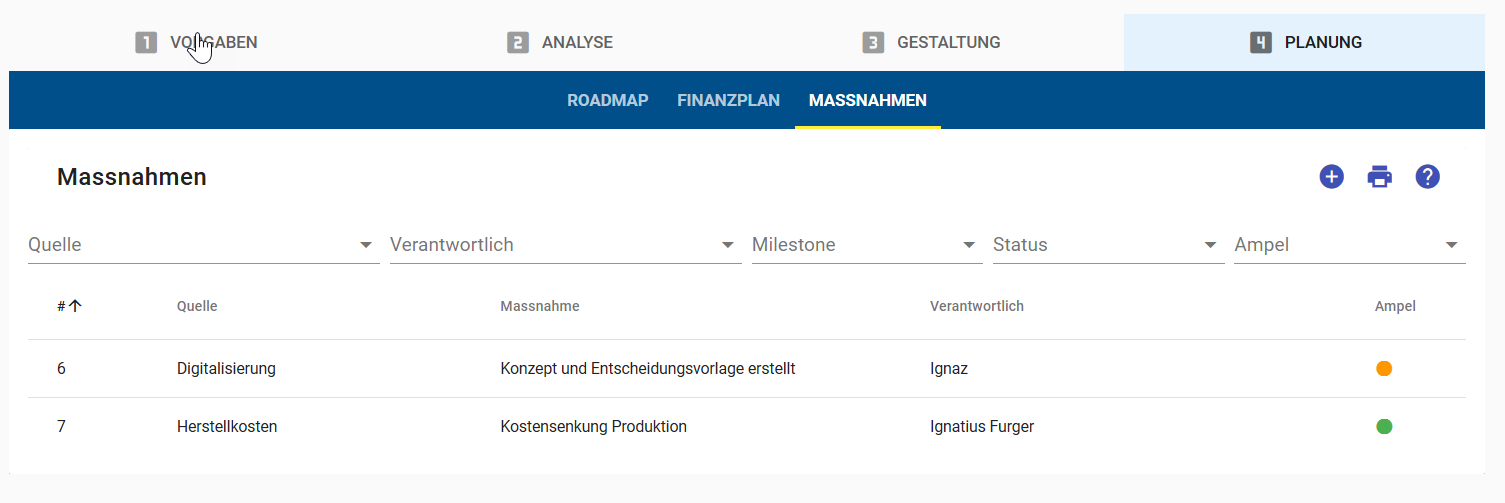
By clicking on a line, the corresponding measure is displayed in detail:

Any number of milestones can be created for each measure. The data, i.e. Start and end are entered for the milestones. The measures take as the beginning the smallest start date and as the end the largest end date of the Milestones.
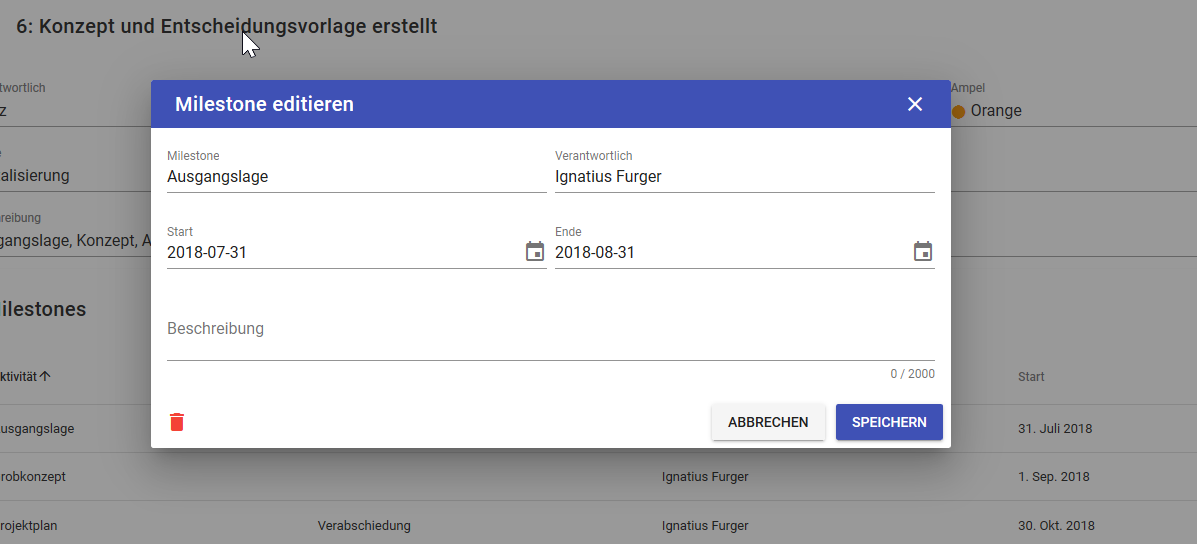
A measure is usually divided into three to five milestones.
The traffic light is only entered at measure level and can have three values:
- green: everything ok
- yellow: attention, could get out of hand
- red: danger, the measure is in danger and must be revised
It is up to the user to define the meaning of green-yellow-red.
Statements can be added or changed at any time to the measures. These are listed in chronological order and thus chronologically indicate the development of the measure.
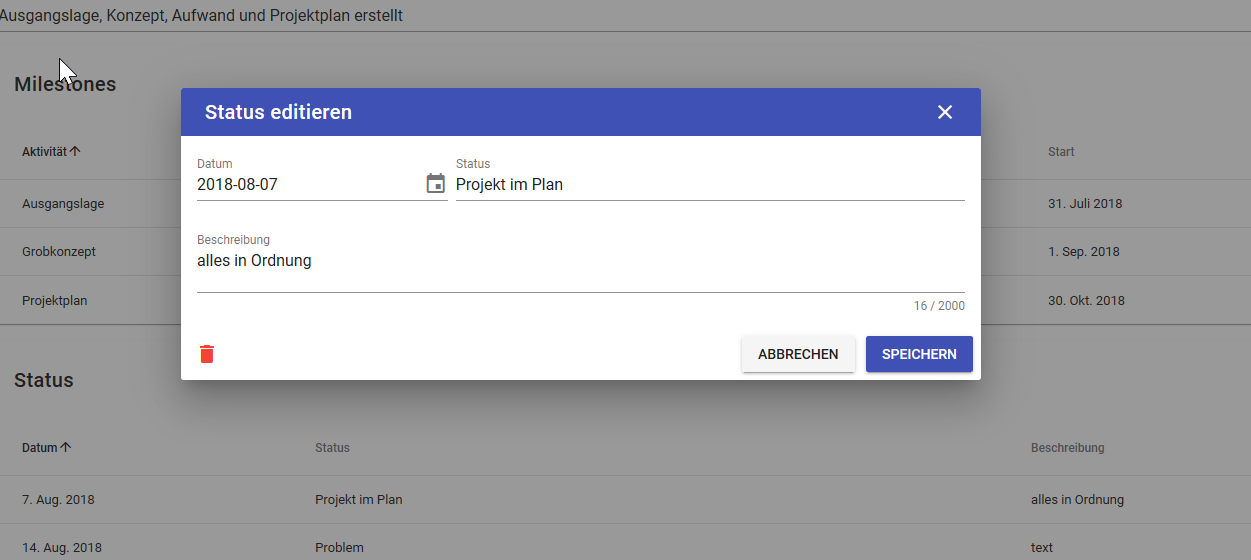
Note: we do not create an activity plan here that we track every day. It's about recording the results. It is a question to show the results. Also, we will not set up project management here. There are other tools and the strategic management of a company is not interested in the daily work, but only in the result.
← Tools Business Units →
